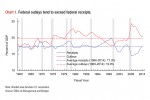The Federal Budget: Constraints Limit the Options
If we are to understand why the federal budget is structured the way it is and why fiscal policy choices are constrained, we must look at history to see how we got to where we are today. The nature of fiscal policy is such that decisions made by earlier generations affect the options of future generations. This was true in the past and it is true today—our choices will shape the opportunities of future generations.
In the end, we believe the future economic health of the nation depends on building agreement around the budget facts. This report is one step on that path.
The Past Primes the Present
In fiscal year 2014, the federal government collected the equivalent of 17.5 percent of the gross domestic product (GDP) as tax revenues, but its outlays were larger, at 20.3 percent of GDP (see Chart 1). The difference, 2.8 percent of GDP, represents the federal budget deficit, the amount that had to be borrowed to finance government operations. Since 1960, the federal budget has been in deficit in all but six years.
Federal Budget Snapshot
Fiscal Year 2014
Revenues: $3,022 billion
Outlays: $3,506 billion
Deficit: $485 billion
Fiscal Year 2014
Revenues: $3,022 billion
Outlays: $3,506 billion
Deficit: $485 billion
In the past few years, during the Great Recession and its aftermath, federal outlays were substantially higher than the historical average, reaching as high as 24 percent of GDP in 2009. At the same time, a slowing economy resulted in tax revenues falling to under 15 percent of GDP, substantially below the long-term average (see Chart 1). This is typical of a recessionary period, when falling incomes bring down tax revenues and increased expenditures on government transfer payments, such as unemployment insurance and disability benefits, raise the outlays. The result was much higher deficits than the historical norm, reaching almost 10 percent of GDP in 2009. The aftereffects of the recession seem to be passing now, and revenues, outlays, and deficits are approaching their historical averages (see Chart 2).
For more than 50 years, federal outlays have, on average, exceeded federal revenues. From 1960 to the present, federal revenues averaged about 17 percent of GDP and expenditures averaged nearly 20 percent of GDP. While that’s been the steady state, Chart 1 illustrates that there’s much variation year to year, in part because during recessions, revenues tend to fall and expenditures tend to rise.
The gross federal debt, the total amount of borrowing by the federal government that is still outstanding, reached $17.8 trillion in 2014, the latest year for which we have complete data. But a lot of that is owed to other parts of the United States government. For example, some of the Treasury bonds that have been issued to finance past deficits are held by the Social Security Administration in the Social Security trust fund and in several other federal government accounts. These funds have not really been borrowed from the private economy; rather, they are being shifted from one federal government entity to another.
To accurately measure the accumulated debt, one must look at the funds that have been borrowed from, and therefore are owed to, non-government sources. This measure is called the federal debt held by the public. By September 2014, the end of the fiscal year, it reached $12.8 trillion. This equals about 74 percent of GDP, the highest value since 1950. Hypothetically, if the United States wanted to repay all of its outstanding debt in one year (not something that is possible in reality), it would take the entire economy about nine months to produce the wealth required to do so. And since almost half (47.5 percent) of that debt is held by foreigners, for four and-a-half months, the entire output of the U.S. economy would be shipped to other countries.
Federal fiscal years run from Oct. 1 to Sept. 30 and are denoted by the year in which they end. Thus, fiscal year 2014 ran from Oct. 1, 2013, to Sept. 30, 2014.
Future Challenges and Risks
Today, the federal debt held by the public, at 74 percent of GDP, is the highest since 1950. Even more worrying, however, is that the debt is projected to grow continuously in the coming decades. The nonpartisan Congressional Budget Office (CBO) projects that, absent changes in the current policies, the federal debt held by the public will exceed 100 percent of GDP about 20 years from now (see Chart 3).
The continuous growth in the debt and the debt-to-GDP ratio raises three concerns.
Long-term growth is threatened. The federal borrowing required to finance the growing deficits will divert funds from private investment. This ultimately results in a smaller stock of capital than would have been possible otherwise and thus slower growth of the productive potential of the U.S. economy. Economists describe this as “government spending crowding out private investment.”
We will spend a larger share of the budget on servicing our debt. In the current low interest-rate environment, net interest on federal debt amounts to 1.3 percent of GDP. These are funds that are not available for other uses, such as investment in science, education, or in productive capital. The CBO projects this share to increase to 4.3 percent of GDP by 2035 because, not only will our borrowing increase, but in addition, interest rates will rise from their current very low levels.
Perhaps the greatest threat, however, comes as the outstanding debt restricts the ability of policy makers to respond to unexpected future events. When a recession or a crisis hits, policy makers often choose to increase spending and cut taxes to stimulate the economy and speed up the recovery. When the national debt is high and a substantial portion of tax revenues is tied up in interest payments on the debt, there is not much space to increase spending further or to cut taxes. The ability to use fiscal policy to address unexpected challenges faced by the economy will be curtailed.
The Structural Problem
For both economic and political reasons, there is a limit to federal revenues. Too much taxation slows the economy, and high tax rates incentivize people and companies to avoid taxation by legal and illegal means.
Since 1960, taxes levied on individuals (through the income tax and payroll taxes) accounted for the majority of federal tax revenues. And, their share has grown over time—from 60 percent in 1960 to 80 percent in 2014.
The increase in tax revenues collected from payroll taxes is responsible for this change. Payroll taxes accounted for only 16 percent of all federal receipts in 1960 but for 34 percent in 2014. This increase is due to the introduction in 1965 of Medicare and the taxes associated with it as well as the increase in both Social Security and Medicare tax rates over this period.
Simultaneously, the share of federal receipts collected from corporate income taxes fell from 23 percent in 1960 to about 11 percent in 2014, and the share collected from excise taxes fell from about 12 percent to around 3 percent. In other words, today the vast majority of federal revenues come from the taxes directly associated with individuals—income taxes and payroll taxes.
Since the end of World War II, irrespective of the tax rate, the federal government has collected, on average, the equivalent of about 17 percent of GDP in taxes. But the long-term projections from the CBO show that going forward, federal outlays will be substantially greater. In fact, they are projected to stay above 20 percent of GDP from 2015 onward (see Chart 3).
To prevent the deficit and debt from rising without having to change federal spending, tax revenues would need to exceed 20 percent of GDP consistently. That has not happened since World War II. Tax revenues reached but did not exceed 20 percent of GDP only once, in 2000. Unless there is a substantial change in the federal government’s ability to collect tax revenues, it is doubtful that budget deficits will be reduced or eliminated by increased taxation alone. Therefore, some adjustment to federal spending will have to be a part of the solution. But when we look at the spending side, we see challenges and constraints that illustrate the difficulty of making these changes.
Federal tax revenues, as well as other budgetary totals, should be measured as a share of the gross domestic product (GDP) because the GDP represents the productive activity of the U.S. economy—the ultimate source from which government can collect its tax revenue. Viewing the budget in this way also facilitates comparison over long stretches of time, during which the economy changes substantially.
Changing Places
Back in the 1960s, about two thirds of federal outlays went to what is called discretionary spending. This includes spending on national defense and on nondefense needs, such as education and training, science and technology, environment, international affairs, and others. National defense alone accounted for about 45 percent of the federal spending in the 1960s. These outlays are called discretionary because they are decided, and can be adjusted, every year in the appropriation bills passed by Congress.
The other type of outlays, called mandatory outlays, are not decided in the annual appropriations process, but rather are set by legislation that determines participant eligibility for programs. They include all of the major social insurance programs, such as Social Security, Medicare, Medicaid, subsides through the health insurance exchanges, unemployment compensation, and other income security programs. To adjust these outlays, change in the original legislation governing each program is required, which is much more difficult to accomplish.
Over time, the relative sizes of discretionary and mandatory federal spending essentially have switched places. In the 1960s, about two-thirds of the federal budget was discretionary spending and 30 percent was mandatory. (The remainder went to pay interest on the national debt, which is not technically classified as mandatory spending, but which the Congress has always viewed as unquestionable.) Today we see the opposite—only one-third of federal spending is discretionary, while 60 percent is mandatory. This means that congressional appropriations decisions are made on a small and shrinking portion of the budget.
According to the CBO, growing mandatory outlays are the reason for the projected rise in federal spending, and thus the rise in deficit and debt, in the coming decades. Mandatory outlays are ultimately driven by the aging population and health care costs. These two forces together push up the outlays for the largest federal programs created decades ago—Social Security and Medicare.
Social Security outlays are projected to rise over 25 years from 4.9 percent of GDP in 2014 to 6.3 percent of GDP in 2039. The outlays for major federal health care programs will rise even faster, from 4.9 percent of GDP in 2014 to 8 percent in 2039. (Major health care programs include Medicare, Medicaid, Children’s Health Insurance Programs, and subsidies offered through health insurance exchanges.)
The projections of these trends are fairly accurate because the mandatory outlays are essentially set on autopilot by the legislation that created these programs. And because these programs, like Social Security and Medicare, are enormously popular, altering that legislation in the direction that reduces the outlays is politically difficult. Yet the resource constraint will eventually force changes, as it always does with unsustainable trends.
The Choices We Face
It is difficult to make decisions about the federal budget strictly on economic grounds, as it will be exceedingly hard to create consensus around projected revenues and expenditures.
An alternative budget strategy would be to create consensus around the idea that economic growth should outpace the growth of the debt. Doing so would put the nation on a trajectory of economic stability and provide us with the capacity to respond to national emergencies.
This national debate does not occur in a vacuum. One aspect of the current context is concern about inequality. The national conversations about the debt and about inequality have some common characteristics. The inequality debate focuses on complaints that prosperity has not been shared. Underlying the deficit debate is a fear that sacrifice will not be shared. We believe that with an agreement on the facts and a commitment to share both sacrifice and gains, Americans are both wise enough and compassionate enough to tackle both conversations.
Myths and Realities
Claim
The defense budget is much larger than it has been in the past.
Reality
In fiscal year 2014, national defense outlays were around $600 billion, about 17 percent of all federal outlays and 3.5 percent of GDP. These values are close to the lowest level seen since 1940. They were slightly lower only in the period of 1996-2001, when we ran budget surpluses. Relative to the size of the economy and to the size of the federal budget, outlays on the national defense are close to the lowest level in many decades. As a portion of discretionary spending, defense spending today accounts for about half of discretionary spending, where in the 1960s it accounted for more than 65 percent.
Claim
We can significantly reduce budget deficits without having to change Social Security or Medicare.
Reality
Changes to mandatory federal outlays, of which Social Security and Medicare are major components, are necessary if we are to avoid growth in deficits and debt. All of the projected increase in the federal deficit comes from the rise in mandatory outlays, which today account for 60 percent of all federal spending. The share of discretionary spending in federal outlays is now close to the lowest level ever. In 2014, it was only 33 percent. The CBO projects that over the next 25 years, mandatory outlays will increase by about 60 percent. Even if discretionary outlays were cut to zero, the savings achieved would not be sufficient to eliminate the budget deficits over this period.
Claim
We can solve the future fiscal problems by raising additional taxes, for example, by restoring highly progressive tax rates that existed in the 1950s.
Reality
Maybe, but doubtful. Since the end of World War II, irrespective of the tax rates, the federal government has collected, on average, about 17 percent of GDP in taxes. But federal outlays are projected to rise substantially above this level, reaching about 26 percent by 2039. To prevent deficits and debt from rising, tax revenues will have to rise similarly. The federal government has never been able to collect that much in taxes, not even in the era of highly progressive income tax rates in the 1950s, when the top marginal tax rate reached 90 percent. Higher marginal tax rates do not guarantee higher tax revenues.
[pdf-embedder url=”https://www.aier.org/wp-content/uploads/2015/05/IB_May2015_FederalBudget.pdf“]
In fiscal year 2014, national defense outlays were around $600 billion, about 17 percent of all federal outlays and 3.5 percent of GDP. These values are close to the lowest level seen since 1940. They were slightly lower only in the period of 1996-2001, when we ran budget surpluses. Relative to the size of the economy and to the size of the federal budget, outlays on the national defense are close to the lowest level in many decades. As a portion of discretionary spending, defense spending today accounts for about half of discretionary spending, where in the 1960s it accounted for more than 65 percent.
Claim
We can significantly reduce budget deficits without having to change Social Security or Medicare.
Reality
Changes to mandatory federal outlays, of which Social Security and Medicare are major components, are necessary if we are to avoid growth in deficits and debt. All of the projected increase in the federal deficit comes from the rise in mandatory outlays, which today account for 60 percent of all federal spending. The share of discretionary spending in federal outlays is now close to the lowest level ever. In 2014, it was only 33 percent. The CBO projects that over the next 25 years, mandatory outlays will increase by about 60 percent. Even if discretionary outlays were cut to zero, the savings achieved would not be sufficient to eliminate the budget deficits over this period.
Claim
We can solve the future fiscal problems by raising additional taxes, for example, by restoring highly progressive tax rates that existed in the 1950s.
Reality
Maybe, but doubtful. Since the end of World War II, irrespective of the tax rates, the federal government has collected, on average, about 17 percent of GDP in taxes. But federal outlays are projected to rise substantially above this level, reaching about 26 percent by 2039. To prevent deficits and debt from rising, tax revenues will have to rise similarly. The federal government has never been able to collect that much in taxes, not even in the era of highly progressive income tax rates in the 1950s, when the top marginal tax rate reached 90 percent. Higher marginal tax rates do not guarantee higher tax revenues.
[pdf-embedder url=”https://www.aier.org/wp-content/uploads/2015/05/IB_May2015_FederalBudget.pdf“]
Changes to mandatory federal outlays, of which Social Security and Medicare are major components, are necessary if we are to avoid growth in deficits and debt. All of the projected increase in the federal deficit comes from the rise in mandatory outlays, which today account for 60 percent of all federal spending. The share of discretionary spending in federal outlays is now close to the lowest level ever. In 2014, it was only 33 percent. The CBO projects that over the next 25 years, mandatory outlays will increase by about 60 percent. Even if discretionary outlays were cut to zero, the savings achieved would not be sufficient to eliminate the budget deficits over this period.
Claim
We can solve the future fiscal problems by raising additional taxes, for example, by restoring highly progressive tax rates that existed in the 1950s.
Reality
Maybe, but doubtful. Since the end of World War II, irrespective of the tax rates, the federal government has collected, on average, about 17 percent of GDP in taxes. But federal outlays are projected to rise substantially above this level, reaching about 26 percent by 2039. To prevent deficits and debt from rising, tax revenues will have to rise similarly. The federal government has never been able to collect that much in taxes, not even in the era of highly progressive income tax rates in the 1950s, when the top marginal tax rate reached 90 percent. Higher marginal tax rates do not guarantee higher tax revenues.
[pdf-embedder url=”https://www.aier.org/wp-content/uploads/2015/05/IB_May2015_FederalBudget.pdf“]
Maybe, but doubtful. Since the end of World War II, irrespective of the tax rates, the federal government has collected, on average, about 17 percent of GDP in taxes. But federal outlays are projected to rise substantially above this level, reaching about 26 percent by 2039. To prevent deficits and debt from rising, tax revenues will have to rise similarly. The federal government has never been able to collect that much in taxes, not even in the era of highly progressive income tax rates in the 1950s, when the top marginal tax rate reached 90 percent. Higher marginal tax rates do not guarantee higher tax revenues. [pdf-embedder url=”https://www.aier.org/wp-content/uploads/2015/05/IB_May2015_FederalBudget.pdf“]











